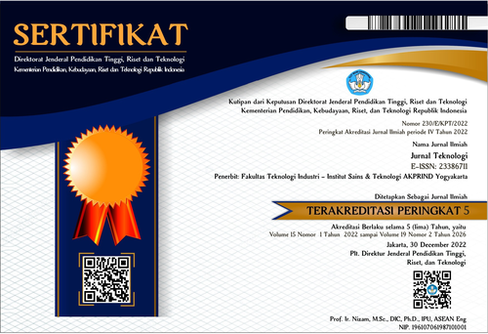Optimasi Kondisi Proses Maserasi Daun Strobilantes Cusia
DOI:
https://doi.org/10.34151/jurtek.v15i2.3539Keywords:
absorbance, dye, naturalAbstract
The process of taking natural dyes from strobilanthes cusia leaves in a very simple way is carried out at UMK Shiungu Temanggung. The process was carried out by soaking the leaves and twigs of the cusia strobilantes in water, with a time of 3 days, and a solvent-to-material ratio of 6:1. The raw materials in the form of intact leaves and twigs cause the maceration results to be less than optimal and cause waste in the form of leaves and twigs which are increasingly stinking. Starting from this problem, it is necessary to carry out research to be able to determine the best conditions for the dye collection process. The maceration process, which was carried out using intact leaves and twigs of Cusia strobilantes that were not chopped, with a maceration time of three days and a solvent-to-material ratio of 6:1, resulted in a solution with a very small absorbance value. For red color with a wavelength of 678 nm the solution has an absorbance value of 2.375. Whereas for the purple color with a wavelength of 409 nm the solution has an absorbance value of 5.275. In addition, the waste obtained is difficult to process because it is large and interlocking and smells bad so it disturbs the environment. Research on the process of maceration of Cusia strobilantes leaves with variations in leaf size, a ratio of solvent to material, and maceration time, shows that the smaller the size of the material and the greater the time used, the greater the absorbance value of the macerated solution, while the ratio of solvent to material indicates an optimal point. The best conditions chosen are process conditions that produce maximum maceration results and facilitate the waste treatment process
Downloads
References
Chairunnisa, S., Wartini, N. M., & Suhendra, L. (2019). Pengaruh Suhu dan Waktu Maserasi terhadap Karakteristik Ekstrak Daun Bidara (Ziziphus mauritiana L.) sebagai Sumber Saponin. Jurnal Rekayasa dan Manajemen Agroindustri ISSN, 2503, 488X.
Dachriyanus, 2004, Analisis Struktur Senyawa Organik Secara Spektrofotometri, hal 1- 37, Andalas University Press, Padang.
Lemmens, H. MJ dan N Wulijarni-Soetjipto. 1999. Sumber Daya Nabati Asia Tenggara Nomor 3 Tumbuhan Penghasil Pewarna dan Tanin. Jakarta: Balai Pustaka
Owen, Tony. (1996). Fundametal of Uv-Visible Spectroscopy. Germany: Hewlett Packard Company.
Sastrohamidjojo, H. (2007). Spektroskopi. Yogyakarta: UGM Press.
Suhartati, Tati. (2013). Dasar-Dasar Spektrofotometri UV-Vis dan Spektrometri Massa Untuk Penentuan Struktur Senyawa Organik. Lampung: AURA
Susanto, Sewan. 1973. Seni Kerajinan Batik Indonesia. Yogyakarta: BPKB.
Treybal. 1980. Mass-Transfer Operations. 3rd ed. McGraw-Hill International, Singapore.
Ul-islam, Shahid. (Eds). (2017). Plant-Based Natural Products Derivative and Applications. Hobooken: Whiley
Voigt R. 1994. Buku Pelajaran Teknologi Farmasi. Edisi ke-5. diterjemahkan oleh: Soendani Noerono. Yogyakarta: Gajah Mada University Press.
Yu, H. dkk. (2021) ‘Strobilanthes cusia (Nees) Kuntze, A Multifunctional Traditional Chinese Medicinal Plant, And Its Herbal Medicines: A Comprehensive Review’, Journal of Ethnopharmacology. Elsevier B.V., 265 (1166)
Yuniwati, M., Pratiwi, W., Kusmartono, B., Sunarsih, S., 2022, Pengaruh Waktu Proses dan Ukuran Bahan terhadap Efektivitas Proses Maserasi Daun Strobilantes Cusia, Jurnal Teknologi, Volume 15, Nomor 1.
Downloads
Published
How to Cite
Issue
Section
License
Copyright (c) 2022 Murni Yuniwati

This work is licensed under a Creative Commons Attribution 4.0 International License.
Jurnal Teknologi provides immediate open access to its content in order of making research freely available to the public to support a global exchange of knowledge. All articles published in this journal are free for everyone to read and download, under licence CC BY SA.
Benefits of open access for the author, include:
- Free access for all users worldwide.
- Authors retain copyright to their work.
- Increased visibility and readership.
- No spatial constraints.




















